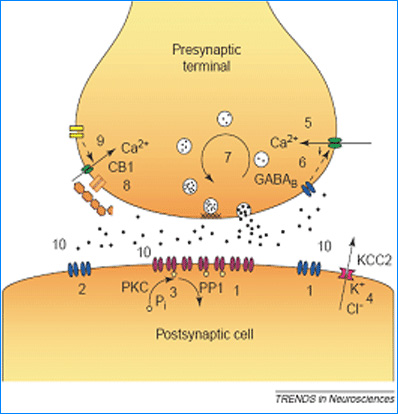|
 We study the regulation of synaptic transmission and neuronal excitability. We record the excitatory and inhibitory ionic currents resulting from the brief activation of various ligand-gated receptor/channels. These channels are opened by the bindings of excitatory (e.g., L-glutamate) or inhibitory (e.g., gamma-aminobutyric acid, a.k.a. GABA) amino acid neurotransmitters. In high resolution recordings we can establish the conductance, number, kinetics and second messenger-dependent modulation of postsynaptic receptor/channels or study the presynaptic processes controlling neurotransmitter release. Molecular biological and pharmacological approaches are used to disable certain receptor types while conserving others to reveal fundamental mechanisms underlying receptor subunit assembly and aggregation at synapses. Recently, we have been investigating compounds which act as allosteric modulators at GABAA receptors (GABAARs). Specifically, we targeted ethanol and neurosteroids (brain metabolites of sex- and stress steroid hormones) because we have shown these compounds to act preferentially at certain GABAARs with a specific subunit composition that are situated extrasynaptically. Elucidating the effects of allosteric modulators on neuronal excitability may aid in devising novel treatments for many neurological diseases. Current projects involve investigating the contribution of specific GABAAR subunits to the phasic and tonic inhibitions in different brain regions and different cell types, investigating the impact of physiological state on inhibition, the influence of seizures on GABAAR reorganization, and investigating the mechanism of GABAAR assembly and trafficking. We study the regulation of synaptic transmission and neuronal excitability. We record the excitatory and inhibitory ionic currents resulting from the brief activation of various ligand-gated receptor/channels. These channels are opened by the bindings of excitatory (e.g., L-glutamate) or inhibitory (e.g., gamma-aminobutyric acid, a.k.a. GABA) amino acid neurotransmitters. In high resolution recordings we can establish the conductance, number, kinetics and second messenger-dependent modulation of postsynaptic receptor/channels or study the presynaptic processes controlling neurotransmitter release. Molecular biological and pharmacological approaches are used to disable certain receptor types while conserving others to reveal fundamental mechanisms underlying receptor subunit assembly and aggregation at synapses. Recently, we have been investigating compounds which act as allosteric modulators at GABAA receptors (GABAARs). Specifically, we targeted ethanol and neurosteroids (brain metabolites of sex- and stress steroid hormones) because we have shown these compounds to act preferentially at certain GABAARs with a specific subunit composition that are situated extrasynaptically. Elucidating the effects of allosteric modulators on neuronal excitability may aid in devising novel treatments for many neurological diseases. Current projects involve investigating the contribution of specific GABAAR subunits to the phasic and tonic inhibitions in different brain regions and different cell types, investigating the impact of physiological state on inhibition, the influence of seizures on GABAAR reorganization, and investigating the mechanism of GABAAR assembly and trafficking.
|
 GABA Receptors
GABA Receptors  GABA Receptors
GABA Receptors